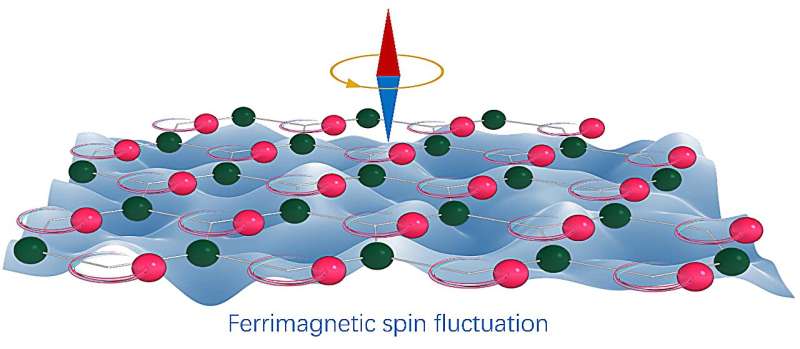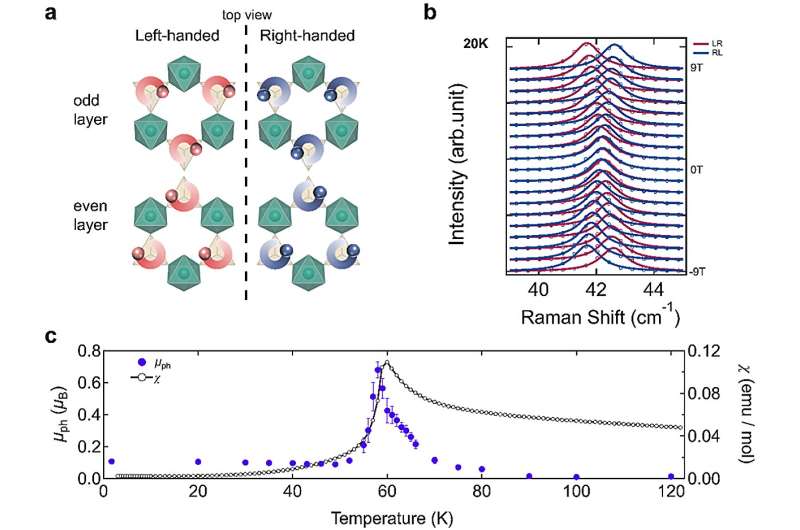October 28, 2023 feature
This article has been reviewed according to Science X's editorial process and policies. Editors have highlighted the following attributes while ensuring the content's credibility:
fact-checked
peer-reviewed publication
trusted source
proofread
Study uncovers giant fluctuation-enhanced phonon magnetic moments in a polar antiferromagnet

Phonons, quasi-particles associated with sounds or lattice vibrations, can carry momentum and angular momentum. However, these quasi-particles are commonly considered to possess negligible magnetic moments.
Researchers at Nanjing University and the Chinese Academy of Sciences recently carried out an experiment investigating the phonon magnetic moments of Fe2Mo3O8, a polar antiferromagnet. Their study, featured in Nature Physics, uncovered giant phonon magnetic moments enhanced by spin fluctuations in Fe2Mo3O8.
"Recent discoveries of large phonon magnetic moments (PMM) in non-magnetic topological systems inspired us to think about the magnetic properties of phonons in a spin-ordered system," Qi Zhang, one of the researchers who carried out the study, told Phys.org.
"At first glance, the various types of spin-lattice interaction should support large PMM in magnetic materials, however, it has not yet been identified before this work. The roles of many-body correlations and fluctuations in the formation of PMM were unclear."
The key objective of the recent work by Zhang and his colleagues was to better understand the interplay between phonons and magnetism. To do this, they carried out a series of experiments on the antiferromagnet Fe2Mo3O8.
"The large magnetic moments of phonons provide a direct link between the lattice vibration and all kinds of magnetic processes, which enables new opportunities for phononic control of magnetic dynamics as well as novel spin information devices based on PMM," Zhang explained. "In terms of the choice of material system, we focus on the type-Ⅰ multiferroic Fe2Mo3O8, which exhibits a remarkably large thermal Hall coefficient, indicating strong spin-lattice coupling."

In their experiments, Zhang and their colleagues used two key techniques, namely magneto-Raman spectroscopy and inelastic neutron scattering. These techniques allowed them to uncover the phononic nature of a pair of low-lying excitations at 42 cm-1 (5.3 meV) in Fe2Mo3O8 single crystals.
"We then obtained the phonon magnetic moments (PMM) of these modes via the phonon Zeeman effect, namely by measuring the slope of the phonon frequency shift in polarization-resolved Raman spectroscopy under magnetic fields," Zhang said. "An unusual PMM enhancement was found near the boundaries between the antiferromagnetic and paramagnetic phases."
This recent experimental study was a joint research effort involving Prof. Yuan Wan's team at the Chinese Academy of Sciences and Prof. Jinsheng Wen's lab at Nanjing University. Prof. Wan's group carried out a symmetry analysis to outline a minimal model that captured the essential physics underpinning the experiment, while Prof. Wen synthesized the sample and collected the neutron measurements.
"The most striking finding of this paper is the 600% ferrimagnetic fluctuation enhancement of PMM near the magnetic transition," Zhang said. "In principle, such fluctuation enhancement could offer a PMM that surpasses the magnetic moment of an electron or a magnon mode (2 Bohr magneton) and even diverges with the magnetic susceptibility."
The researchers ultimately detected a sixfold enhancement of the phonon magnetic moment in their sample. In the future, their work and the theoretical microscopic model summarizing their observations could pave the way for new interesting discoveries about the interplay between magnetism and phonons.
"On one hand, we now plan to extend this work into the non-equilibrium regime, for instance, we are interested in chiral phonons-driven magnetic dynamics or even transient ferromagnetism," Zhang added. "On the other hand, for a phonon with a large magnetic moment, we plan to explore how it behaves in a thermal transport process, and whether a phononic version of the spin Hall effect can happen in this system."
More information: Fangliang Wu et al, Fluctuation-enhanced phonon magnetic moments in a polar antiferromagnet, Nature Physics (2023). DOI: 10.1038/s41567-023-02210-4.
Journal information: Nature Physics
© 2023 Science X Network


















